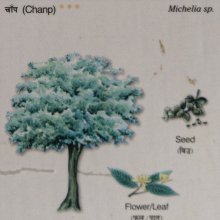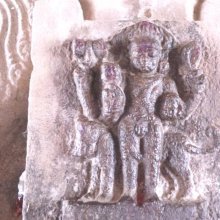Cap, Cāp: 8 definitions
Introduction:
Cap means something in Hinduism, Sanskrit. If you want to know the exact meaning, history, etymology or English translation of this term then check out the descriptions on this page. Add your comment or reference to a book if you want to contribute to this summary article.
Alternative spellings of this word include Chap.
Images (photo gallery)
In Hinduism
Vyakarana (Sanskrit grammar)
Source: Wikisource: A dictionary of Sanskrit grammarCāp (चाप्).—The fem. affix आ (ā), applied to words ending in the tad. affixes ञ्यङ् (ñyaṅ) and ष्यङ् (ṣyaṅ); e. g. कौसल्या, वाराह्या, गौकक्ष्या (kausalyā, vārāhyā, gaukakṣyā); cf Kas, on P. IV. 1. 74.

Vyakarana (व्याकरण, vyākaraṇa) refers to Sanskrit grammar and represents one of the six additional sciences (vedanga) to be studied along with the Vedas. Vyakarana concerns itself with the rules of Sanskrit grammar and linguistic analysis in order to establish the correct context of words and sentences.
Languages of India and abroad
Sanskrit dictionary
Source: DDSA: The practical Sanskrit-English dictionaryCap (चप्).—I. 1 P. (capati) To console, soothe. -II. 1 U. (capayati-te)
1) To grind, pound, knead.
2) To cheat.
Source: Cologne Digital Sanskrit Dictionaries: Shabda-Sagara Sanskrit-English DictionaryCap (चप्).—[capa] r. 1st cl. (capati) To caress, to coax, to soothe or console, r. 10th. cl. (capayati-te) To grind or pound. (i) capi r. 1st and 10th cls. (campati, campayati) To go, to move. bhvā-para-saka-seṭ curā-ubha-saka-seṭ .
Source: Cologne Digital Sanskrit Dictionaries: Benfey Sanskrit-English DictionaryCap (चप्).—i. 1. [Parasmaipada.] To soothe. i. 10, [Parasmaipada.] 1. To grind. 2. To deceive.
Source: Cologne Digital Sanskrit Dictionaries: Monier-Williams Sanskrit-English DictionaryCap (चप्):—[class] 1. pati, to caress, soothe, console, [Dhātupāṭha xi, 5] : [class] 10. capayati, ‘to pound, knead’, or ‘to cheat’, [xxxii, 82].
Source: Cologne Digital Sanskrit Dictionaries: Yates Sanskrit-English DictionaryCap (चप्):—capati 1. a. To caress. (ka) capayati 10th to grind. (ki, i) campati, campayati 1. 10. a. To go.
[Sanskrit to German]
Sanskrit, also spelled संस्कृतम् (saṃskṛtam), is an ancient language of India commonly seen as the grandmother of the Indo-European language family (even English!). Closely allied with Prakrit and Pali, Sanskrit is more exhaustive in both grammar and terms and has the most extensive collection of literature in the world, greatly surpassing its sister-languages Greek and Latin.
See also (Relevant definitions)
Starts with (+494): Capa, Capa -Kana -Kara -Dini -Dishi, Capa de la reina, Capa Theri, Capa-vanpulu, Capabhaga, Capacanem, Capacapa, Capacapanem, Capacaratti, Capacarya, Capacete-de-jupiter, Capacopa, Capacu, Capacupa, Capada, Capadacapada, Capadaka, Capadalakha, Capadasa.
Ends with: Baical skullcap, Baikal skullcap, Barbed skullcap, Black cap, Chinese skullcap, Co san cap, Foolscap, Juniper hair cap, Muong bo-cap, Nakcap, Peyincap, Pois du cap, Yunnan skullcap.
Full-text (+170): Topi, Shirastrana, Nalakini, Shiraska, Topadem, Apadamastaka, Janumandala, Cakridara, Kuncadem, Paridamshita, Patrapishacika, Shirastra, Kapola, Night-caps, Co san cap, Garama-topi, Shiratopa, Gaha, Kuppemani, Garitopi.
Relevant text
Search found 62 books and stories containing Cap, Cāp; (plurals include: Caps, Cāps). You can also click to the full overview containing English textual excerpts. Below are direct links for the most relevant articles:
Mystery of the Missing Cap < [April – June, 1987]
The Mystery of the Missing Cap < [October 1990 – December, 1990]
The Goddess Speaks < [March 1948]
Vakyapadiya of Bhartrihari (by K. A. Subramania Iyer)
Verse 3.14.177 < [Book 3 - Pada-kāṇḍa (14): Vṛtti-samuddeśa (On Ccomplex Formation)]
Kathasaritsagara (the Ocean of Story) (by Somadeva)
Notes on the “magical articles” motif in folk-lore < [Notes]
Note on the “hand of glory” < [Notes]
Appendix 2.2 - Umbrellas < [Appendices]
Tibetan tales (derived from Indian sources) (by W. R. S. Ralston)
Flower Adornment Sutra Preface
The gods of northern Buddhism (by Alice Getty)
Related products
(+1 more products available)











